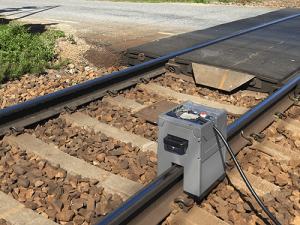First developed in 2005 with the assistance of Network Rail, the G-Scan rail instrument sends guided waves down the length of a rail to look for any areas of cross section change. The guided waves that are created in the rail are able to detect cracks and corrosion in any section of the rail, including the ‘foot’ and ‘toe’.
Because of this ability to detect corrosion areas that are normally hidden from higher frequency methods that access the rail from the head, the G-Scan system is often used to inspect level crossings that are susceptible to foot corrosion, but are difficult to inspect without disrupting both rail and road traffic. Guided wave inspection performed from outside of the level crossing can inspect the section while the road is still fully operational; rail traffic is often not disturbed if the period between trains is long enough. The results allow you to rank the crossings, extending the mandatory lifting time for some crossings, prioritising replacement for others.
The current generation of the G-Scan uses the Wavemaker® G4 electronics and the WavePro software to collect, analyse, and report the guided wave data.
First developed in 2005 with the assistance of Network Rail, the G-Scan rail instrument sends guided waves down the length of a rail to look for any areas of cross section change. The guided waves that are created in the rail are able to detect cracks and corrosion in any section of the rail, including the ‘foot’ and ‘toe’.
 Because of this ability to detect corrosion areas that are normally hidden from higher frequency methods that access the rail from the head, the G-Scan system is often used to inspect level crossings that are susceptible to foot corrosion, but are difficult to inspect without disrupting both rail and road traffic. Guided wave inspection performed from outside of the level crossing can inspect the section while the road is still fully operational; rail traffic is often not disturbed if the period between trains is long enough. The results allow you to rank the crossings, extending the mandatory lifting time for some crossings, prioritising replacement for others.
Because of this ability to detect corrosion areas that are normally hidden from higher frequency methods that access the rail from the head, the G-Scan system is often used to inspect level crossings that are susceptible to foot corrosion, but are difficult to inspect without disrupting both rail and road traffic. Guided wave inspection performed from outside of the level crossing can inspect the section while the road is still fully operational; rail traffic is often not disturbed if the period between trains is long enough. The results allow you to rank the crossings, extending the mandatory lifting time for some crossings, prioritising replacement for others.
The current generation of the G-Scan uses the Wavemaker® G4 electronics and the WavePro software to collect, analyse, and report the guided wave data.
subscribe to receive promotions and offers, and download the content
You have successfully subscribed to the newsletter
There was an error while trying to send your request. Please try again.
Thanks for your download!
SAVE CLOSE THIS MESSAGE AND CLICK THE PDF YOU WANT TO DOWNLOAD, WE ARE HAPPY TO BE ABLE TO OFFER WHAT YOU WERE LOOKING FOR